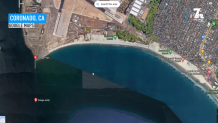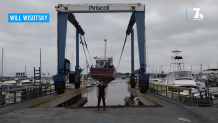It’s not what you usually see at the beach.
On Breaker’s Beach, part of Naval Air Station North Island in Coronado, there is a blue and tan rectangular structure sitting squarely on top of what used to be a floating barge. It has several glass windows and a large opening leading to what looks to be a deck. The roof is even complete with shingles.
In short, it's not something you’d expect to see floating in the ocean, let alone sitting on the sand.
The United States Coast Guard was notified about the houseboat at around 6:45 p.m. on Friday, according to USCG Petty Officer Alex Grey. It washed up when bands from Tropical Storm Kay were slowly swiping across San Diego, bringing strong winds and surf with it.
Get San Diego local news, weather forecasts, sports and lifestyle stories to your inbox. Sign up for NBC San Diego newsletters.
While it isn’t the first vessel to run aground during a storm along this portion of shoreline, the unique look has caused a discussion among social media users. Some who are familiar with the area look at the houseboat as a fixture that they are sad to see beached while others were quick to quip about it becoming San Diego’s next million-dollar property for sale.
There were two people inside of the houseboat when it washed ashore. Neither of them were injured in the ordeal, according to Grey. Since then, the houseboat was deemed hazardous, likely because of household materials on board, which were taken by USCG personnel.
Local
Now, the whole vessel needs to be removed. Grey said that is typically the owner’s responsibility but since it is on the base at NAS North Island, it is a different story.
According to U.S. Navy Public Affairs Officer Kevin Dixon, the process to remove boats that wash onto the base can be lengthy, and expensive. In general, Dixon said the first step is to get in contact with the boat’s owner. They have 45 days to investigate and find the person, then once the owner comes forward, they have another 45 days to decide if they want to reclaim and remove the boat.
If they do not want to take responsibility, then the Navy has to pay to have it removed.
The process to destroy and haul away the boats typically costs around $20,000 each time, which Dixon said comes out of the Navy’s budget for other things. The boat owners do not front any cost or face any penalty if they choose to turn over the boat to the Navy.
In the case of the houseboat, Dixon added, the owner was one of the two people found on the boat at the time it washed ashore. Grey said that it came from an area known to have boats near Zuniga Jetty.

Dixon said most boats that come in from that area during storms are empty. Their mooring breaks and no one is there to stop them, leaving them to the will of the waves. The Zuniga area used to be managed by the City of San Diego but that is no longer the case.
“In the past couple of years, the City of San Diego has entered into memoranda of understanding (MOU) with the Port of San Diego so that the Harbor PD can enforce the applicable laws at Zuniga,” City of San Diego Media Services Manager Monica Muñoz said in a statement emailed to NBC 7. Muñoz added that the City of Coronado and Port of San Diego are now in on the agreement, too, and contributing funding toward managing the area.
Will Wisotsky grew up in San Diego and didn't know much about the boating community until he bought a boat to live on a few years ago so that he could practice music out on the water without bothering neighbors. Wisotsky spent about two years living on his boat in the San Diego area. He sailed to different locations, including the Zuniga area, or “the zu” as he calls it.

“The Zuniga Jetty comes off the north shore of Coronado, and it’s the rock jetty there, and people come around and anchor behind it because it sort of protects you from the swells,” said Wisotsky. “If you have, like, a really shallow draft, like, the boat doesn’t go too far in the water and you can tuck in really close, it’s practically flat out there.”
After speaking with Wisotsky for just a few moments, it’s clear he could tell stories about the experience, and the people he met, for hours. After having a daughter, Wisotsky explained he now lives on land, but the memories he made while sailing around will last a lifetime.
“You’re always sandy, you’re always wet, but then there’s these moments when you’re like, you’re leaving the harbor and watching the sunrise over San Diego or you’re watching it set over the ocean and you’re just like, there’s nowhere in the world that you’d rather be,” added Wisotsky.
As for how long the houseboat has been floating near Coronado, it is hard to say. Some people who are familiar with the area say they noticed it a few months ago. NBC 7 tried to reach the owner of the houseboat but were not able to get in touch.
So, some of the houseboat’s story still remains a mystery.



